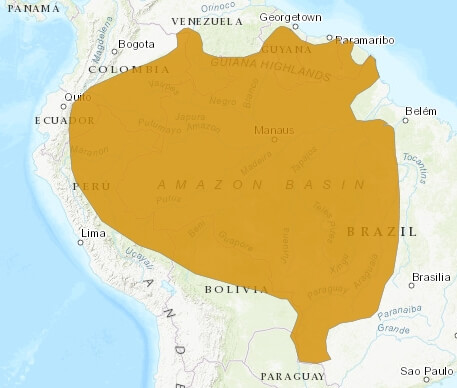Giant Otter
Pteronura brasiliensis
©Adriano Gambarini
Taxonomy
Standard English Name
Giant Otter
Scientific Name
Pteronura brasiliensis
Brazilian common name/s
Ariranha
Conservation status - IUCN
Physical Description
One of the largest carnivores in South America, reaching 100 to 180 cm long and 22 to 34 kg in weight. It is quite similar to the neotropical otter, but is larger, has white spots on its throat and the terminal portion of the tail is flattened.
The coat is short with a brown coloration. The feet are broad, with webbed toes. The tail is very muscular at the base and is used as a rudder during turns in the water.
Ecology and Habitat
They occur in South America, from the east of Ecuador and Peru to northern Argentina and are mainly found in forests or wetlands together with slow moving rivers. They are active during the day and spend most of the time in the water. Giant otters choose specific places for sleeping and nesting in the vegetation along the riverbanks.
They have an interesting social system, with groups of 4 to 8 individuals, comprising a monogamous breeding pair and their offspring. There can also be temporary associations between neighbouring groups with up to 20 individuals. Giant Otters communicate using a number of different vocalizations, 9 of which have been studied. The groups have territories of approximately 12 km2.
The diet consists mainly of fish, crabs and occasionally other small vertebrates. The prey is captured with the mouth and secured with the paws to be consumed, often while the animal swims on its back.
Gestation lasts 65 to 70 days, with the female giving birth to between 1 and 5 young.
Threats and Conservation
Their populations have been greatly reduced due to hunting for their fur, habitat destruction and associated water pollution by pesticides, industrial waste and mercury. It is classified by the IUCN (International Union for Conservation of Nature) as Endangered and by IBAMA, as threatened with extinction.
Online links
IUCN redlist (http://www.iucnredlist.org) presents a synthesis of current knowledge about distribution and conservation status.
IUCN Otter Specialist Group – http://www.otterspecialistgroup.org
IUCN OSG Bulletin – http://www.otterspecialistgroup.org/Bulletin/IUCNOSGBull.html
References
Cabral, M. M. M., Zuanon, J., de Mattos, G. E., & Rosas, F. C. W. (2010). Feeding habits of giant otters Pteronura brasiliensis (Carnivora: Mustelidae) in the Balbina hydroelectric reservoir, Central Brazilian Amazon. Zoologia, 27, 47-53.
Carter, S. K., & Rosas, F. C. W. (1997). Biology and conservation of the giant otter Pteronura brasiliensis. Mammal Review, 27, 1-26.
Carter, S. K., Fernando, C. W., Copper, A. B., & Cordeiro-Duarte, A. C. (1999). Consumption rate, food preferences and transit time of captive giant otters Pteronura brasiliensis: Implications for the study of wild populations. Aquatic mammals, 25, 79-90.
Duplaix, N., Waldemarin, H. F., Groenedijk, J., Evangelista, E., Munis, M., Valesco, M., & Botello, J. C. (2008). Pteronura brasiliensis. In: IUCN 2010. IUCN Red List of Threatened Species. Version 2010.2.. , , Downloaded on 05 July 2010.
Emmons, L. H., & Feer, F. (1997). Neotropical rainforest mammals: a field guide. Chicago: University of Chicago Press.
Leuchtenberger, C., & Mourao, G. (2008). Social organization and territoriality of giant otters (Carnivora : Mustelidae) in a seasonally flooded savanna in Brazil. Sociobiology, 52, 257-270.
Michalski, F., & Peres, C. A. (2005). Anthropogenic determinants of primate and carnivore local extinctions in a fragmented forest landscape of southern Amazonia. Biological Conservation, 124, 383-396.
Rosas, F. C. W., Zuanon, J. A. S., & Carter, S. K. (1999). Feeding ecology of the giant otter, Pteronura brasiliensis. Biotropica, 31, 502-506.
Uscamaita, M. R., & Bodmer, R. (2010). Recovery of the Endangered giant otter Pteronura brasiliensis on the Yavari-Mirin and Yavari Rivers: a success story for CITES. Oryx, 44, 83-88.
